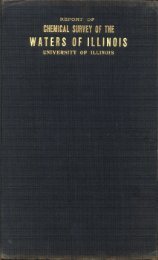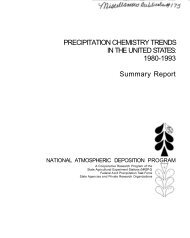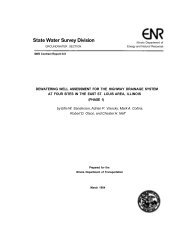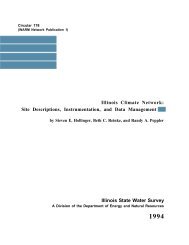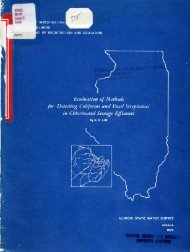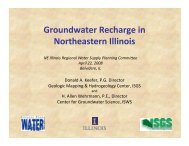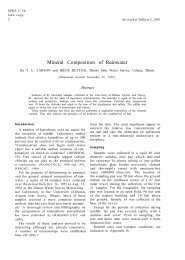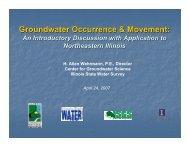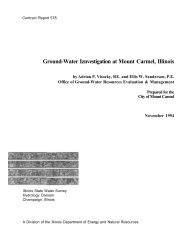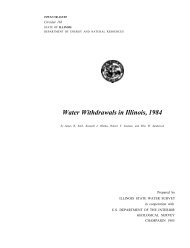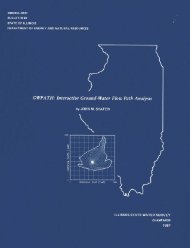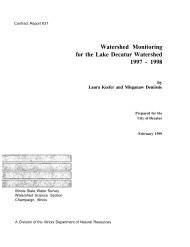Ground-water development in East St. Louis area, Illinois. Urbana, IL ...
Ground-water development in East St. Louis area, Illinois. Urbana, IL ...
Ground-water development in East St. Louis area, Illinois. Urbana, IL ...
You also want an ePaper? Increase the reach of your titles
YUMPU automatically turns print PDFs into web optimized ePapers that Google loves.
The model was developed on the premise that ground<strong>water</strong><br />
flow <strong>in</strong> the <strong>East</strong> <strong>St</strong>. <strong>Louis</strong> <strong>area</strong> is two-dimensional.<br />
The f<strong>in</strong>ite-difference form of the partial differential equation<br />
(Jacob, 1950) govern<strong>in</strong>g the nonsteady state twodimensional<br />
flow of ground-<strong>water</strong> is (see <strong>St</strong>allman,<br />
1956):<br />
(23)<br />
where:<br />
h 1 = head at node 1 (see figure 60A; the aquifer is<br />
subdivided <strong>in</strong>to small squares of equal <strong>area</strong>, the<br />
<strong>in</strong>tersections of grid l<strong>in</strong>es are called nodes); h 1 (i =<br />
2, 3, 4, and 5) = heads at nodes 2 to 5; a = width<br />
of grid <strong>in</strong>terval; T = coefficient of transmissibility;<br />
and S = coefficient of storage.<br />
Cont<strong>in</strong>u<strong>in</strong>g the comparison, <strong>water</strong> moves <strong>in</strong> an aquifer<br />
just as charges move <strong>in</strong> an electrical circuit. The quantity<br />
of <strong>water</strong> is reckoned <strong>in</strong> gallons while the charge is<br />
<strong>in</strong> coulombs. The rate of flow of <strong>water</strong> past any po<strong>in</strong>t <strong>in</strong><br />
the aquifer is expressed <strong>in</strong> gallons per day while the flow<br />
of electricity is <strong>in</strong> coulombs per second or amperes. The<br />
hydraulic head loss between two po<strong>in</strong>ts <strong>in</strong> an aquifer is<br />
expressed <strong>in</strong> feet while the potential drop across a part<br />
of the electrical circuit is <strong>in</strong> volts.<br />
Thus, there are four units which are analogous;<br />
there is necessarily a scale factor connect<strong>in</strong>g each unit <strong>in</strong><br />
one system to the analogous unit <strong>in</strong> the other system.<br />
Know<strong>in</strong>g the four scale factors the hydrologist is able to<br />
relate electrical units associated with the analog model to<br />
hydraulic units associated with an aquifer. The four<br />
scale factors, K 1 , K 2 , K 3 , and K 4 , were def<strong>in</strong>ed by Bermes<br />
(1960) as follows:<br />
(25)<br />
(26)<br />
(27)<br />
Figure 60.<br />
F<strong>in</strong>ite-difference grid (A), resistor-capacitor net (B),<br />
and pump<strong>in</strong>g rate oscilloscope trace (C)<br />
where:<br />
(28)<br />
Consider a resistor-capacitor network with a square<br />
pattern as shown <strong>in</strong> figure 60A and network junctions at<br />
nodes as def<strong>in</strong>ed <strong>in</strong> figure 60B. The junctions consist of<br />
four resistors of equal value and one capacitor connected<br />
to a common term<strong>in</strong>al; the capacitor is also<br />
connected to ground. The relation of electrical potentials<br />
<strong>in</strong> the vic<strong>in</strong>ity of the junction, accord<strong>in</strong>g to Kirchhoff's<br />
current law, can be expressed by the follow<strong>in</strong>g<br />
equation (see Millman and Seely, 1941; and Skibitske.<br />
1961):<br />
where:<br />
(24)<br />
Comparison of equations 23 and 24 shows that the<br />
f<strong>in</strong>ite-difference equation govern<strong>in</strong>g the nonsteady state<br />
two-dimensional flow of ground <strong>water</strong> <strong>in</strong> an <strong>in</strong>f<strong>in</strong>ite<br />
aquifer is of the same form as the equation govern<strong>in</strong>g<br />
the flow of electrical current <strong>in</strong> a resistor-capacitor network.<br />
For every term <strong>in</strong> equation 23 there is a correspond<strong>in</strong>g<br />
term of the same order of differentiation <strong>in</strong><br />
equation 24.<br />
The analogy between electrical and aquifer systems<br />
is apparent. The hydraulic heads, h, are analogous to<br />
electrical potentials, V. The coefficient of transmissibility,<br />
T, is analogous to the reciprocal of the electrical resistance,<br />
1/R. The product of the coefficient of storage, S,<br />
and a 2 is analogous to the electrical capacitance, C.<br />
The analogy between Ohm's law and Darcy's law is<br />
established by the fact that the coefficient of transmissibility<br />
is analogous to the reciprocal of the electric<br />
resistance. Substitution of these laws <strong>in</strong> equation 27 results<br />
<strong>in</strong> the follow<strong>in</strong>g equation which may be used to<br />
determ<strong>in</strong>e the values of the resistors of the <strong>in</strong>terior portions<br />
of the analog model (see Bermes, 1960):<br />
where:<br />
(30)<br />
R = resistance, <strong>in</strong> ohms; and T = coefficient of transmissibility,<br />
<strong>in</strong> gpd/ft.<br />
The follow<strong>in</strong>g equation (see Bermes, 1960), which<br />
may be used to determ<strong>in</strong>e the values of the capacitors of<br />
the <strong>in</strong>terior portions of the analog model, may be derived<br />
by tak<strong>in</strong>g <strong>in</strong>to consideration the def<strong>in</strong>itions of the coefficient<br />
of storage and capacitance and the analogy between<br />
(a 2 S) and C.<br />
where:<br />
(31)<br />
G = capacitance, <strong>in</strong> farads; a = network spac<strong>in</strong>g, <strong>in</strong><br />
feet; and S = coefficient of storage, fraction.<br />
53



